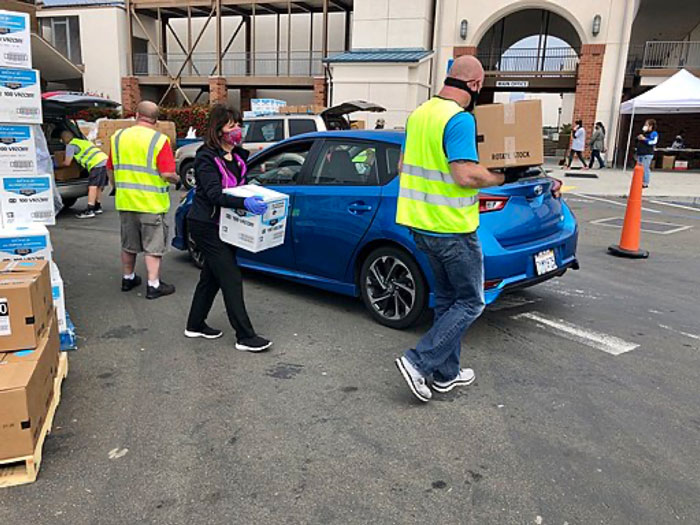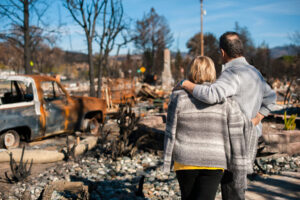The Definition of Human Services
Posted on June 14, 2021 by
Human services are all about helping people find stability, and can include everything from providing for basic needs like food and shelter to offering guidance, counseling and substance abuse treatment with the goal of promoting self-sufficiency and happiness in people’s lives.
Human service definitions are notoriously difficult to pin down. When you think about it, what are human services if they aren’t pretty much everything? Any kind of social service seems like it could fit the definition of human services. And you will find that the term has different meanings in different contexts.
A human services college degree, for example, can refer to any one of a family of related degrees in several health and social service specializations, from social work to counseling… but the term degree in human services refers very narrowly to associate, bachelor’s or master’s in human services specifically.
What Is Human Service Work Defined By Today?
What Are The Different Kinds of Human Service Fields?
What Is Human Services Going To Be Defined By In The Future?
Human Services Is Defined By Actions and Outcomes
Like other professions, however, human services has worked to define itself over time. The many examples of human services we see every day build on that definition:
- In Santa Clara, an Army veteran found both a job and a purpose in life working in an assistance program to help other veteran’s coping with PTSD. After a decade, his position was eliminated and he found himself unemployed and working piece-meal, survival-level jobs that didn’t ever quite pay enough to keep he and his family above water. With assistance from human services workers with CalWORKS and Veteran’s Affairs, however, he received housing assistance, money to get his car repaired, and even good clothes to wear to job interviews. He was able to transition back into a well-paying professional position with his county’s elections department after getting those boosts.
- In Florida, a family of six had a comfortable life before COVID hit. With the father’s construction job sidelined, the family had to start selling furniture and household goods to get by. Soon, even that wasn’t enough, and six hungry mouths needed some real help. Enter Second Harvest Food Bank. Their Food Finder program helped the family locate nearby resources for nutrition assistance, and soon they were receiving enough milk, eggs, produce, and staples to keep both kids and parents fed through the darkest moments of the pandemic.

Workers at Second Harvest Food Bank are an example of human services in action. Photo by Jackie Speier, Public domain, via Wikimedia Commons
- In Tulsa, prisoners who have recently been released from jail face a lot of challenges: substance abuse issues, lack of jobs, social stigma. But Fitting Back In, a non-profit agency that specializes in helping ex-cons get past all of those issues and more with counseling, career development, and life skills training lead by human services professionals, helps break the cycle of incarceration. The program boasts an 85 percent success rate, helping Oklahoma achieve one of the lowest prisoner recidivism rates in the entire nation.
These human services examples are all about achievement. The real story of what are human services is in the details. The kids saved from hunger, the people who avoid going back to jail, the depressed who are made happy and whole. There are no words that can completely express the huge achievement of successful human services every day in this country. You can only try to understand it by seeing what is possible.
What Is Human Service Work Defined By Today?
A human service can be said to be an act that supports a person. But we’re not using the term to talk about helping little old ladies cross the street. Acts of compassion and care are vital in human services, but the term includes a sense of organization and purpose. Human services work is work, not just a good deed.
And because human needs are so varied and deep, human services have to exist on an interdisciplinary level.
There’s no one single kind of skill or expertise that can be said to define human services. In the broadest sense, then, human services may be defined as the services that are provided to people in order to help them stabilize their lives and find self-sufficiency through guidance, counseling, treatment, and the provision of basic needs.
Another notable aspect of the human services definition is that those services are typically delivered to individuals in crisis, or to address a chronic problem afflicting society as a whole. Human services are designed to stabilize those crises and provide meaningful paths to happy and healthy lifestyles for individuals. On the population level, they work to correct systemic issues that create illness or lead to endemic racism or economic inequality.
You might imagine from that vast range of needs and systems that there would be a lot of different specializations that fall into the definition of human services. You would be right!
Human Services Definitions Exist At Multiple Levels
First, you have to understand that the definition of human services can vary depending on what people are trying to describe.
On the large scale, dictionary definitions cover it well:
human services
plural noun
programs or facilities for meeting basic health, welfare, and other needs of a society or group, as of the poor, sick, or elderly.
That covers the broad spectrum of programs in half a dozen different fields that people are talking about when they are talking about supporting the disadvantaged in society.
But to define what human services are within that bigger picture takes a different approach. A human services degree from college doesn’t instantly qualify you to work in all of the various specialized fields within that broad scope. Instead, it’s designed to prepare you for a specific kind of human services work that exists alongside social work, therapy, and psychology as its own field of expertise.
That specialization is actually a kind of generalist role. It exists as an interdisciplinary field that ties the other kinds of human services expertise together into a strong web of support for society.
NOHS, the National Organization for Human Services, offers a better definition that addresses the question, “what is human services?”:
The field of Human Services is broadly defined, uniquely approaching the objective of meeting human needs through an interdisciplinary knowledge base, focusing on prevention as well as remediation of problems, and maintaining a commitment to improving the overall quality of life of service populations. The Human Services profession is one which promotes improved service delivery systems by addressing not only the quality of direct services, but also by seeking to improve accessibility, accountability, and coordination among professionals and agencies in service delivery.
In this sense, the profession of human services is the glue that ties together the various specializations within the field. The role of the human services professional is to be the glue and the base on which all types of human services can rely. It’s a kind of infrastructure for caring for individuals and entire populations.
Who Came Up With The Original Definition of Human Services?
As a distinct academic discipline, human services didn’t emerge until the 1960s. While professions in the broader human services sector like social work, psychology, and counseling had been around since the late 1800s, the connections between them had often been discounted. They emerged to deal with specific issues within their own lanes of expertise. A larger conceptual framework to tie them together only came later.
 The foundation of the field of human services as a distinctive discipline had to be done by people from other fields—there was no interdisciplinary expertise or identity before they came along to build one.
The foundation of the field of human services as a distinctive discipline had to be done by people from other fields—there was no interdisciplinary expertise or identity before they came along to build one.
So it’s no surprise that the man considered to be the father of human services was, by profession and training, a psychiatrist.
Harold McPheeters was the head of the first mental health and cognitive disability program at the Southern Regional Education Board (SREB) from the mid-1960s until the late 1980’s. Working with the National Institutes of Mental Health (NIMH), McPheeters was instrumental in hammering out what would become the first dedicated curriculum guidelines for a true interdisciplinary human services degree.
A dedicated degree in the field was key to the establishment of human services as a recognized profession. What human services professionals are taught in classrooms today and what they do in the field is still defined in part by the work of McPheeters and others as they established the National Organization for Human Services (NOHS) in 1975 to act as the standard-bearer for the profession.
There were efforts by some of those specific fields to broaden their perspective, such as the foundation of the National Human Services Assembly in the 1920s, which was established by the National Social Work Council as an outreach effort. They pursued better cooperation between agencies dealing with social and human services issues and the finances and funding obstacles.
The work of SERB and NIMH, spurred on by Harold McPheeters, were instrumental in helping create a sustainable collective vision of the human services as well as the specific profession as it is taught today.
In 1980, the federal Department of Health, Education, and Welfare was formally renamed to the Department of Health and Human Services. With that, the human services sector had an official federal stamp of approval.
What Are The Different Kinds of Human Service Fields?
Under the big tent of human services, there are a wide array of specialties. When discussed collectively, these fields are all part of the definition of human services.
- Social Work – Social work careers involve work that is most closely associated with human services historically. The combination of advocating for societal support and improvements in the lives of people everywhere with individual actions to support those people really embodies the whole human services ethos. Social workers operate in a broad range of capacities, but they are known for looking at the big picture and getting results not just for their clients, but also making changes that will benefit all of society in the long run.
- Psychology – Psychology is one of the oldest human services professions and really stands on its own as a field with a long history and lasting impact on society.Becoming a psychologist involves providing human services both individually, by offering therapeutic treatment to individuals and groups, and collectively, by advising corporations and government on the structure of support programs and the impact of policy. Psychologists undergo some of the most rigorous training of any human services profession. Those working in clinical treatment have doctoral degrees and are licensed for practice by the state they work in.
- Therapy – Therapy occupies a similar niche to psychology, but with a focus on direct treatment of patients. Therapists often specialize in a particular field, like juvenile therapy or marriage and family therapy. They use the same psychological principles and techniques as clinical psychologists. Therapists only work in treatment, however, and are not often found in policy or consultation work. They can work independently or for healthcare or social services organizations.
- Counseling – Human services professionals that become counselors find that the work can overlap with therapists, social workers, and psychologists. The job is distinguished by taking a practical approach to solving the problems of patients and how it is largely defined into affliction-specific specializations. For example, there are addiction counselors, mental health counselors, and job counselors. They take a systematic approach to dealing with the immediate issues that are causing problems for their clients.
- Sociology – Professionals with advanced degrees in sociology make important contributions to the field of human services by collecting data and providing analysis of just what kinds of services are needed and how effective they are. Sociologists provide a population-level perspective on what sort of problems a society is facing. Their knowledge of history and the forces that work through culture and the economy is invaluable to other human services professionals in diagnosing major issues and coming up with effective interventions.
- Correctional Work – Many individuals in need of human services supports find themselves in trouble with the law at some point. With one of the largest percentages of incarcerated population in the world, American human services work definitely needs workers like correctional treatment specialists to offer specialized assistance in rehabilitating prisoners and assisting them with connecting to other social services. Minimizing the difficulties of a transition from the prison system to society eases the long term demands on both systems.
- Emergency Management – Like correctional worker, emergency management is a highly specific aspect of human services. But emergencies are exactly when human services are needed the most, and when conventional human services systems are unavailable. Emergency management specialists have the skills and training to step into chaotic situations with limited resources and start getting people the help they need through direct assistance or coordination with a wide variety of human services agencies and non-profits like the Red Cross. The Department of Health and Human Services even has a dedicated Office of Human Services Emergency Preparedness and Response to plan for these events.
While these are all commonly accepted fields within the overall definition of human services, there is also the general field of human services itself. It is the profession that fills in the gaps in all the others, and provides the support and connection that each of the separate specializations need to effectively work with all the rest.
Is There A Legal Human Services Definition?
There is no exact legal definition of human services, but since court cases are sometimes heard that involve the field, the courts have often offered judgements that contribute to human services’ definition.
One of the most important of those decisions in recent history was National Federation of Independent Business v. Sebelius, the landmark suit against the Department of Health and Human Services (the director of which at the time was Kathleen Sebellius) over the Patient Protection and Affordable Care Act: Obamacare.
The suit, in part, argued that the Medicaid expansion provisions in the law constituted an illegal use of Congress’ spending power. The law originally required all states to expand their Medicaid coverage or risk losing existing funding for that vital human service. But the Supreme Court ruled that existing funding could not be threatened in that way, guaranteeing that the millions already covered by Medicaid services would not be at risk of losing their healthcare services.
With a Supreme Court that has been reshaped by new appointments in recent years, the definition of human services in the legal world is likely to be shifted even more by upcoming decisions.
What Are Human Services Workers Trying to Accomplish?
Sometimes you can find a human service definition by looking at the goals that workers in the field are trying to accomplish. Although there are many different functions in human services work, they are all working toward the same goal.
Human services aims to help individuals live productive, rewarding lives.
Human services is an interdisciplinary field because it takes so many different specializations and supports to achieve that goal. There can be all kinds of different obstacles to having a good life:
- Poverty
- Addiction
- Disease and disability
- Mental illness
- Discrimination
- Accidents or disasters
The range of expertise that is needed to handle any, or any combination, of those misfortunes is too big for any single specialization.
So workers in different human services fields all pursue the same objectives. Those who have degrees in human services itself and work in human services positions help tie together all those different professions in order to reach the finish line.
 As a big interdisciplinary field, human services gives people a big tent to pursue their personal passions and innovative ideas. Sometimes, they turn out even bigger than the founders could have imagined.
As a big interdisciplinary field, human services gives people a big tent to pursue their personal passions and innovative ideas. Sometimes, they turn out even bigger than the founders could have imagined.
One of the biggest came from Audrey Cohen. An energetic woman with a nose for social injustice and civic activism, Cohen launched the Women’s Talent Corps in New York in 1964, an organization dedicated to finding jobs for low-income women who had missed out on the post-war boom in the economy. Her focus on women earned her pushback from existing social service organizations, but Federal grants keep the organization going.
By 1969, WTC was a full-fledged success. Cohen, who could see she was on to a winning formula for retraining and boosting low-income workers, stepped up the game: WTC became the College for Human Services in 1970, granting associate’s degrees in the field and putting people from low-income communities back to work serving those very same communities.
The experiential learning format adopted by the College was ahead of its time, but has since become common in human services training.
Today, the college is the highly-respected Metropolitan College of New York, and the Audrey Cohen School for Human Services & Education is only one of several schools that are a part of it. But the goal remains the same, and alumni from the school continue to make a difference in New York City and beyond.
What Is Human Services Going To Be Defined By In The Future?
One truth about society and the definition of human services is that it will always change. The evolving nature of the challenges to human wellness and happiness means that the collection of services that we think of as human services will also have to change.
Global Climate Change May Re-define Human Services Work Around The World
 In May of 2021, a study published in Nature Magazine attributed as many as 35 percent of all heat-related mortality between 1991 and 2018 to climate change. Human services workers have already been dealing with heat waves such as those in France in 2019 that caused 1,500 deaths among the vulnerable and elderly. The study suggests as climate change accelerates, those waves will spread and worsen, including in the United States.
In May of 2021, a study published in Nature Magazine attributed as many as 35 percent of all heat-related mortality between 1991 and 2018 to climate change. Human services workers have already been dealing with heat waves such as those in France in 2019 that caused 1,500 deaths among the vulnerable and elderly. The study suggests as climate change accelerates, those waves will spread and worsen, including in the United States.
American human services workers have already been dealing with drought and the raging forest fires that have come to the American West along with it. In 2020, fires displaced thousands in the midst of the COVID-19 pandemic, creating massive difficulties for emergency workers trying to protect and shelter people.
That kind of multi-modal disaster might become more then norm for human services in the future. And it will make interdisciplinary coordination a more important part of the job than ever. Human services workers will have to coordinate all the different specialties required to address large-scale disasters stemming from flooding, fires, crop failures, and an influx of climate refugees.
Population Disparities Continue To Accelerate and Concentrate Inequality
Something odd happened in the American economy during the COVID-19 pandemic. While millions of workers were suddenly out of a job, the amount of wealth concentrated among the very rich exploded. The Institute for Policy Studies found that billionaire wealth jumped by 55 percent over the 14 months beginning in March of 2020, just as the economy began to shut down.
It’s an example of something experts say to expect more of, which is the continuing concentration of wealth among the already wealthy, and greater economic and political insecurity coming to those who are already disadvantaged.
According to Pew Research, the American middle class has shrunk from 1971 to 2019, putting a bigger gap in the social and income levels between Americans than ever before. Lower tax rates on the wealthy also put social service funding in jeopardy. That may lead to bigger demand for fewer human services resources than ever—with human services workers left to figure out how to distribute them.
That’s going to challenge how society thinks about and funds human services in the decades to come.
Rapidly Evolving Technology Provides Good and Bad Examples of Human Services Changes
The definition of human services is also going to be altered by another fast-paced trend: the advance of technological innovation.
This cuts both ways. During the pandemic, for instance, technologies like Zoom gave human services workers the ability to connect safely to clients in a way that wouldn’t have been possible before. At the same time, a lack of technology access at the lowest levels of society cut off some disadvantaged people more than ever.
With new technologies like artificial intelligence and image recognition being used more and more in areas like law enforcement and healthcare, the potential for tech-driven inequality to cause problems will be higher than ever.
Yet some of the same technology may completely redefine how human services are measured and delivered. The opportunities that science and technology will bring can change human services for the better as well.
Human services workers will be the leaders both in pushing back on harmful trends and embracing the helpful ones. It’s a field that has been built from the ground up by the people who step up to work in it, and it will continue to be built by those dedicated professionals. Employment in human services in the coming decades is going to continue to define what are human services in the real world.




